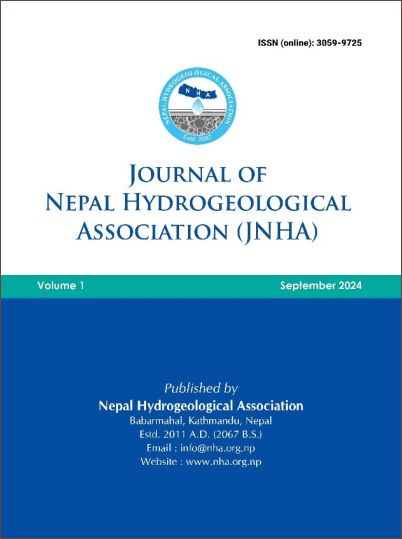Geomorphic assessment of morphology of Siwalik origin rivers in Far-west Nepal
DOI:
https://doi.org/10.3126/jnha.v1i1.78220Keywords:
River morphology, geomorphology, Remote Sensing, InSAR, Siwalik Hills, TaraiAbstract
Geology, tectonics, topography, climate, land use, and human activity impact river morphology significantly, affecting downstream morphology and hydrology. In Nepal, rivers traversing complex geology and active tectonics are subjected to intense weathering and erosion, resulting in a high sediment yield and substantial impacts on river morphology. Despite the importance of understanding river morphology, studies on Himalayan rivers remain limited. This study investigates the characteristics of basin and river morphonology of the Siwalik origin river in far-west Nepal using GIS, remote sensing, field surveys, and hydrodynamic modeling. The basin, spanning 702 km2, features distinct land use patterns, with the upper catchment predominantly forested and the lower catchment heavily agricultural. Geologically, the upper catchment is underlain by Siwalik Group rocks, while the lower reach consists of quaternary deposits. An examination of the catchment characteristics, change in plan and cross-sectional form at various channel reaches was conducted using time series optical satellite imagery and InSAR data from ALOS PALSAR and Sentinel-1. The study revealed that steep and rugged topography, high uplift rates, and intense monsoons contribute to frequent and extensive landslides, which lead to high sediment yield in the basin's upper part and impact channel morphology downstream. The study also exposed the correlation between channel slope, sediment type, and river morphology. The river processes such as erosion (bank and avulsion), deposition, and channel abandonment during the last decade have evidenced changes in the planform of river morphology. The hydrodynamic model indicates that changing hydraulic variables influence the river's processes and morphology. Cross-sectional analysis of the rivers also shows significant variability in sediment aggradation and degradation, impacting bed-level and flow patterns, indicating dynamic river processes. Notable sediment gains at certain cross-sections and losses at others indicate dynamic river processes, impacting bed-level rise, erosion, and flow patterns. A decrease in the annual rates of all river processes (erosion, avulsion, deposition, and channel abandonment) suggests stabilization in riverbanks. Comparatively, deposition remains the most extensive process, which indicates an excessive sediment load from upstream. This research provides a conceptual frame where the independent landscape factors (geology, climate, human activities) and dependent variables (sediment supply, stream discharge) shape river morphology.




